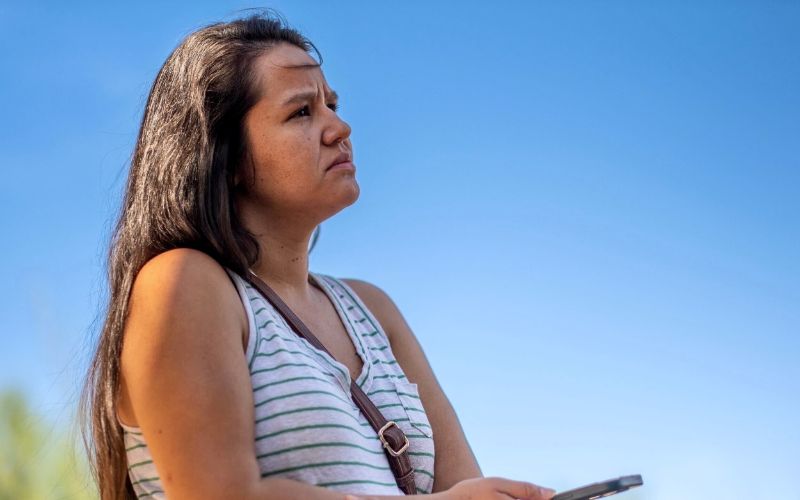
- Details
- By Elyse Wild
Tucson-based media firm Arizona Luminaria this week launched the state’s first database tracking Missing and Murdered Indigenous Women, Girls, Two-Spirit and Transgender (MMIWGTT) people. Reporter Chelsea Curtis (Diné) built the database through a year-long investigation that included nearly 100 public record requests, document analysis, and family interviews. One of her findings: the majority of victims were Navajo women between the ages of 19 and 32.
Curtis spoke with Native News Online’s Senior Health Equity Editor Elyse Wild about creating the database, its impact on tribal communities and the emotional toll of reporting nearly 100 MMIWGTT. This interview has been edited for clarity and brevity.
Before we get into the database, tell me a little about yourself. Where did you grow up?
I’m Navajo, and I grew up on the Navajo Nation in Sanders, right on the Arizona-New Mexico border. I was raised by my single mother with my sister, and my grandparents helped raise me too — we lived with them for a long time. Before high school, we moved to the south side of the Grand Canyon when my mom got a new job, and I graduated high school there. Then I went to Northern Arizona University and graduated in 2015 with a degree in journalism.
What I loved most about growing up on the Navajo Nation was being really close with my family. I miss living out there — being out in the middle of nowhere, that deep connection to the land. It's slower, more in tune with your surroundings and nature. I miss that intimate connection.
How has the issue of MMIP personally affected you or your family?
My grandma had a brother who went missing. I never met him, and it was just something that came up every now and then in conversation. We didn’t know what happened, and now that my grandma and many of my elders have passed, I probably won’t get any real answers.
Beyond that, I grew up experiencing some of the same trauma that often goes hand in hand with these cases—domestic violence, substance abuse, and intergenerational trauma. So while I don’t personally know anyone who has been murdered or is missing, those experiences connect me to this issue.
What inspired you to create this database?
When I was at the Arizona Republic, I covered breaking news and then criminal justice—focused on police. I noticed there was a lack of data on police shootings and crime in tribal nations. Arizona has so many tribes, including the largest, the Navajo Nation, and it seemed strange that we weren’t dedicating more time to covering these issues.
After leaving the Republic, I started working at Arizona Luminaria and pitched this project as part of a larger idea to cover criminal justice issues in tribal nations. They connected me with the International Women’s Media Foundation’s Fund for Indigenous Journalists, and that’s how the database got started.
The IWMF emphasizes that these projects are Indigenous-led, which is important since so few Native people work in newsrooms, especially in leadership.
What were the challenges in creating the database?
I filed a ton of public records requests with almost every police agency in Arizona—over 100. Each agency had different record-keeping systems, and some didn’t respond at all. Some agencies couldn’t filter out active missing persons cases, so I had to read through reports to find relevant ones.
On top of that, interviewing families was emotionally heavy. Doing back-to-back interviews about such traumatic experiences without enough time to process was overwhelming.
How did you handle those difficult moments?
I remember having a check-in call with Tara Gatewood from the IWMF, and she told me it was okay to slow down, to rest, to take a walk. She reminded me that these stories deserve my full attention and that it’s okay to take my time. I actually cried on that call because I was so overwhelmed, but her support really helped.
Did you collaborate with any grassroots MMIP groups while building the database?
Not directly. I would love to collaborate more, especially to improve the database and make it more helpful.
What is your hope for the database?
I want it to be a resource for families—a way for them to understand this issue and hold people accountable for their loved ones. I also hope tribal nations can use it to identify gaps in resources. For example, many of these cases involve intimate partner violence, so I hope this data can push for more resources for domestic violence prevention.
Why was it important to include detailed data, like age groups and tribal affiliations?
I think having detailed data can help tribal nations and other groups focus their resources where they’re most needed. For example, if many cases involve intimate partner violence, more support can go toward addressing that issue.
I’m also working on parsing out more data—like how many cases involve substance abuse, child abuse, or vulnerable individuals like pregnant women or elders—for future updates.
Are you continuing to work on the database?
Yes, I’m still working on it. I have ideas for updates, and I want to expand it to include cases involving men and possibly other states. We also received funding from the Data-Driven Reporting Project to continue for another year.
What’s your long-term goal for the project?
I would love to build a team and expand the database nationally. My big dream is to keep growing it in a way that’s thoughtful and driven by the people it impacts.
Any final thoughts?
I really want families to know this database exists and that it’s here for them. This project is about amplifying voices and shining a light on stories that need to be told.
More Stories Like This
Arizona MMIP Task Force Holds Listening Session for Survivors and Families‘A good stew is a story’ Blackfeet buffalo rancher shares Three Sisters Buffalo Stew recipe
National Indian Health Board Urges Congress to Extend Enhanced Premium Tax Credits
$1.25 Million Grant Gives Hope to Tolowa Dee-ni' Nation Amid Housing Crisis
HHS Repeals Nursing Home Staffing Requirements, Citing Relief for Tribal Facilities


